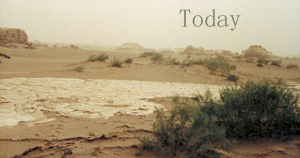
Dong Xuhui, an expert at the National Environment Protection Bureau’s Sandstorm Researchsgroupssaid the storms are a natural phenomenon, and not a new one at that. To the contrary, sandstorms have existed for thousands of years, literally from the beginning of historical records. He noted that dusty and sandy weather is far from being a new phenomenon in China.
Wang Shejiao, of Shaanxi Normal University’s Northwest Historical Environment and Economic Social Development Research Centre, has put forward his view in his article "Research on the Distribution and Reasons of Dusty and Sandy Weather in Chinese History":
In the Eastern Han Dynasty (AD 25-220), historian Ban Gu set aside the "Records of the Five Elements" in his work“The History of the Han”to record the disasters and strange phenomena occurring from the Spring and Autumn Period (770-476 BC) down to the end of the Western Han Dynasty (206 BC-AD 24).
Following this tradition, most works of Chinese dynastic histories, called the "Twenty-Four Histories," have recorded natural disasters. Traditionally, the "Twenty-Four Histories" have taken up the authoritative position in the recording of Chinese history. Thus Wang mainly based his research on these annals.
Wang found that in Chinese annals, there have been very specific recordings of dusty and sandy weather.
For example, in the "Records of the Five Elements," Ban Gu said that the northwestern sky seemed to have caught fire one night. The next morning, powerful winds came from the northwest. The wind appeared reddish brown and quickly filled up every corner of the sky. Throughout the day and night, yellow dust fell on the earth like rain.

Among the recordings, Wang found several appalling notes about the aftermath of the disasters. In the "History of the Song," it is said that in the year 1007 under the reign of Emperor Zhenzong in the Northern Song Dynasty (960-1127), a strong wind brought yellow dust that shrouded the sky. The farm fields around the capital were destroyed. The "History of the Ming" records that in 1590 during the Ming Dynasty (1368-1644), a windstorm carrying sand and dust lasted from morning till night. Numerous houses were devastated.
Time periods
From the 4th century BC until 1900, Wang put the occurrence of dusty and sandy weather in Chinasintosfour periods.
There were only two records of dusty and sandy weather before the 4th century BC. From the 4th till the 10th centuries, 39 such disasters happened. The figure grew to 97 between the 11th and 15th centuries, then 115 in the 400 years before 1900. In the spring of 1677 during the rule of Emperor Kangxi of the Qing Dynasty (1644-1911), a sandstorm lasted for over 40 days.
While the general trend towards dusty weather is increasing, Wang pointed out that there have been five peak sand storms between valley periods.
It is worth noticing that before 1051, there had only been five cases of dusty weather within a time span of 50 years. But from 1051 till 1100 within the Northern Song Dynasty, the number sharply rose to 13. From 1151 till 1200 during the Southern Song Dynasty, an astounding number of 27 sandstorms took place, more than that in any 50-year span between the 4th century BC and 1900. In contrast, from 1368 till 1463 during the Ming Dynasty, Wang didn't find any records of dusty and sandy weather at all.
As for the seasons in which dusty and sandy storms took place the most frequently, spring took up 71 percent among all the 252 records with clear seasonal indications. Winter took up only 7 per cent, while summer and autumn together took up 15 per cent.

Location traces
Apart from time, space is another element Wang has focused on in his studies.
While dusty and sandy weather visited the vast region to the north of the Yangtze River drainage area, the Yellow River and Haihe River drainage areas had been the main stage for such destructive forces of nature.
As the sandy wind blew stronger, it also affected more places in China. Before the 10th century, the middle and upper reaches of the Yellow River often witnessed sandstorms.
Between the 11th and 14th centuries, the location of sandy weather gradually moved eastward. The area to the east of today's Xi'an (the capital of Northwest China's Shaanxi Province), west of Shijiazhuang (the capital of North China's Hebei Province), north of Zhengzhou (the capital of Central China's Henan Province) and south of Hohhot (the capital of North China's Inner Mongolia Autonomous Region) were frequently visited by the sandiest catastrophes.
From the 15th till the 19th centuries, sandstorms moved further east to today's Hebei, Henan and Shandong provinces and the large cities of Beijing and Tianjin.

Forecast:
China to suffer from sandstorm in April When interviewed by reporters, Quan Hao, supervisor of the project of "Sandstorm Research", predicted China would suffer again from sandstorm in April.
Quan Hao noted when introducing the situation to the Commission of Population and Environment of CPPCC that the middle Asian sandstorm areas, one of the four largest, cover Kazakstan, Mongolia and Northwest China. Since those areas are currently the most active sandstorm sources, China is likely to suffer from sandstorms once again.
Sandstorms records in the past years
Referred to the sources of concerning departments, there happened five severe sandstorms in the 1950s, eight in the 1960s, thirteen in the 1970s, fourteen in the 1980s, while there were more than twenty in the 1990s. We give a rough introduction about these sandstorms and dusty weather in the 1990s with a table as following:
|
Year
|
Date
|
Places
|
Damage
|
|
1993
|
4/19-5/8
|
Gansu, Ningxia, Inner Mongolia
|
Heavy
|
|
1994
|
4/6
|
Inner Mongolia
|
unclear
|
|
1995
|
11/7
|
Shandong (more than 40 counties)
|
35 persons died, 121 missing, 320 injured. One billion
yuan lost
|
|
1996
|
5/29-5/30
|
Hexi corridor
|
The most severe one since 1965.
200 million yuan lost in Jiuquan city only
|
|
1998
|
4/5
|
Middle west of Inner Mongolia ,Ningxia,Hexi corridor
|
It even had effect on Jinan Nanjing, Hangzhou.
|
|
4/19
|
Eastern and northern Xinjiang Province
|
Six persons died, 44 missing, 256 injured.
|
|
5/19
|
Northern Xinjiang Province
|
Many big trees were blown down and power lines broken
in the force 9 wind.
|
|
1999
|
4/3-4/4
|
Inner Mongolia especially Hohhot
|
The gusts of wind had reached forces 9-10
|
|
2000
|
3/22-3/23
|
Inner Mongolia
|
Beijing was even affected
|
|
3/27
|
Beijing
|
2 construction workers died, 5 injured, some ads board
were blown down and smashed several cars.
|
| ![]() 本网站由北京信息港提供网络支持
本网站由北京信息港提供网络支持



